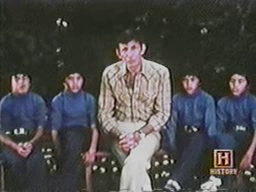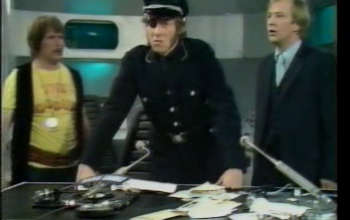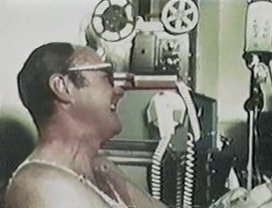In Search Of… S03E03: Cloning
We open on some mice and an eerie musical cue. Nimoy tells us that some of these mice have genes from several other mice, some have genes from only one parent. We move onto some slightly creepy footage of twins and triplets, and Nimoy wonders if identical clones of human beings might be possible.
Best. Opening. Ever.

No, really, it’s hard to do it justice. In Search Of’s great strength is its ability to make riveting television out of not much at all. A camera moving through the woods. A light in a stairwell. A weird guy talking about nothing. Whatever it is, they can make a nothing into a something. This is that ability at its peak:
Mice. Twins. Spooky music. Vague speculation.
I have to watch this!
Twin girls on a swing set. There’s something deeply creepy about twins being dressed the same way. I mean, they’re perfectly fine otherwise, but in the same outfits, it gets very Shining-y, if you follow me. We move onto identical triplets – boys, also playing on a swing. Nimoy claims that ‘primitive people’ hated and feared twins and triplets. Citation needed, I guess?
Nimoy in a check shirt that wouldn’t look too out of place today. He talks about the possibility of cloning people, which isn’t a great way to get into the subject of cloning. I’d start with bananas. Did you know that all commercially cultivated banana trees are clones?
Oh, you did. Fine. Whatever.
Anyway, for purpose of this episode, we’re talking about cloning only in a sci-fi sense of duplicates of people. The camera pulls back, and we see that Nimoy is sitting in the middle of a set of identical quadruplets. Stop making them dress the same way, you monsters!
Nimoy, to my surprise, makes the great point that many SF versions of cloning ignore, which is that if two people are genetically identical, that doesn’t necessarily make them similar in other ways. This concept is illustrated with footage of identical twin sisters in their middle age. They’re dressed similarly (and oddly), but they talk up how different they are. We cut back to the mother of the triplets from earlier, who talks about the differences between her sons, including visible physical differences.
Now we’re talking to one of the only two sets of identical twin gynaecologists in the USA in the late 1970s. I totally just wrote that sentence, didn’t I? Yes, yes I did.
Nimoy now talks about how we must think of clones as human, if we are to ‘rise above primitive tribes.’ Huh. Well, it’s forty years on and anti-clone prejudice isn’t really a thing. So I guess we showed those primitives? Or something?
We’re moving on. Good, I was getting uncomfortable. Nimoy explains where babies come from. If you’re my age, just think of a science class film about reproduction and replace the narrator with Leonard Nimoy and you basically get the idea. He goes on to say that cloning would involve replacing sperm cells with any other cells, and boom, you have a clone. I don’t quite know what happens to the mother’s half of the genetic code, but whatever.
Oh, now we’re talking about cloning in plants. Artificial cloning in orchids – interesting. And, unlike cloning people, there’s actually a point to it. Now a scientist in a redwood forest, selecting trees to clone to make ‘super trees’. She shoots twigs down from the top of the ‘best trees’. Now there’s a job.
Now cloned axolotls. Technicians destroy the genetic information in the white axolotl eggs, and replace it with the DNA of spotted axolotl. It’s really goddamn fascinating. Time laps footage of axolotl cells dividing in the eggs. It’s super awesome.
Nimoy speculates that, if we could clone humans, special people could be replicated indefinitely. But then individuality might be lost. An army of clones might become a master race. Well, that went all Boys from Brazil pretty quickly. Look, there’s no guarantee that a clone of someone special would have the same talents or interests as their parent, and an infectious disease would ravage a clone army in a fraction of the time of a regular army. Don’t get me wrong, this stuff is fun to speculate about, but realistically? There’s about a million real-world problems ready to kill us before the SFnal ones are ready to rumble.
We’re back to the mice. Nimoy points out that the cloning techniques used on plants and amphibians have never been successfully used on mammals. We’re talking to Dr Clem Markard of Yale University, who created mice with six parents. He’s an older academic, and so much less 1970s looking than many of the show’s interviewees. And he lets mice run on his arms, which is cute. Anyway, he made mice with six parents. He basically put together cells from three embryonic mice, and they developed into a single mouse. There’s no mention of whether he uses these hybrid mice to hunt intruders on his private island, but I can only assume so.
He talks about the possibility of cloning mice using microsurgery. We then see some scientists doing microsurgery on mouse egg cells. It’s really friggin’ cool. A technician puts the egg back in a mouse, producing a mouse with only one parent. Markard says there’s no barrier to doing the same thing with people, but you know. Forty years, and still no clone army.
Nimoy talks about the possibility of using cloning as a means of breeding super cows. But before we can explore this, Dr Markham is talking about genetic screening, which is something that actually has happened to some extent… But now we’re talking about cloning again. Markard is trying to fertilise a mouse egg with adult DNA. Axolotl cloning is all done with tadpole cell material.
Basically, it’s not working. Markard talks about cloning adult humans, and claims that it’s no big deal because it’s basically just identical twins with an age difference. But then, after a fairly straightforward episode, In Search Of takes a very In Search Of twist. Nimoy says that identical twins may be more than they seem, and suddenly we’re talking about twin telepathy. The middle aged sisters and the mother of the triplet boys all claim that identical siblings have telepathic connections!
(The twin gynaecologists don’t make this claim, thank goodness. But one of them talks enthusiastically about eugenics instead, which is… a thing.)
Markard suggests that cloning couldn’t be a tool for totalitarianism, because genetic similarity doesn’t lead to similarity of character. Nimoy then wonders aloud if cloning happens, who will control it and to who’s advantage? Could we boost the mental powers of the species? Could it alter our destiny in the universe? He sums up pointing out that variety is essential to survival, and says that cloning could lead us to “evolutionary disaster”.
Well, we dodged that bullet.
It’s easy for me to mock this episode from the point of view of a human-clone-free 2017. When this series was made, this was probably considered one of the more serious episodes, a little primer on the state of some aspects of reproductive research, with a little bit of sensationalism to get people interested. Now, though, it looks like a 1970s version of one of those 1950s era ‘World of Tomorrow’ movies. Just another SF future that never came to pass. No clones, no rocket cars, no cleaning robots, no lunar colonies.
We got cool phones, though. I guess it’ll do.
Quote
“If we are to rise above the superstition of primitive tribes who killed twins we must not think of clones as either less or more than human.” – Nimoy
Summing Up
Science documentary: 6/10, Sensationalism: 8/10, Unexpected turn to the Supernatural: 8/10, Nimoyness: 7/10, Music: 8/10. Overall: 37/50. Credit.



